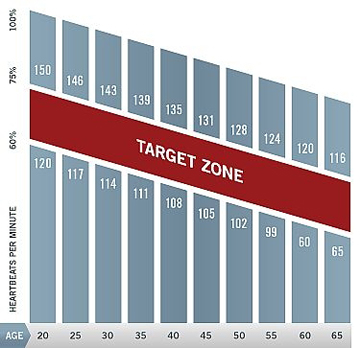Total Therapy Blog
Training Principles… Target Heart Rate
 The past two articles, we’ve focused on different types of training techniques. This is our new short series for those who are looking to get back into shape for the summer but don’t know where to start. In this week’s blog, we’ll talk about Target Heart Rate, a useful tool for getting the most bang for your buck out of an aerobic activity (running, biking, and swimming). To recap – The first technique we talked about was Interval Training and the second technique was Circuit Training.
The past two articles, we’ve focused on different types of training techniques. This is our new short series for those who are looking to get back into shape for the summer but don’t know where to start. In this week’s blog, we’ll talk about Target Heart Rate, a useful tool for getting the most bang for your buck out of an aerobic activity (running, biking, and swimming). To recap – The first technique we talked about was Interval Training and the second technique was Circuit Training.
Target heart rate is a formula that describes a range for your heart rate covering 50% to 85% intensity. The “range” can vary depending on what you want to get out of your aerobic exercise. For example, if you’re just starting with a program, or are coming back after an absence, your recommended range will cover a lower intensity, whereas if you’re looking to push your fitness level, you’ll want to train at a higher intensity to increase your VO2.
Your “target heart rate” is based on your age, maximum heart rate, and current level of fitness. The equation looks like this:
Target Heart Rate (THR) = (Heart Rate max × % Intensity)
Many studies have been conducted on what the “ideal” formula is for estimating maximum heart rate and target heart rate. There’s a variety of equations that can be used, but to cover the widest range of individuals the target heart rate equation is a good option. In order to use it, though, you need to be able to calculate your maximum heart rate. The easiest way to estimate maximum heart rate subtract your age from 220. For example, a 25 year old individual has an estimated maximum heart rate of 195 beats per minute (bpm) (220 – 25 years = 195 beats per minute). His or her 50 – 85% target heart rate range would be between 98 bpm and 166 bpm:
THR = (195 x 0.50) = 98 bpm
THR = (195 x 0.85) = 166 bpm
Your target heart rate range will leave a lot of room to train within, so you might want to narrow it down based on your training goals. If you are just starting a program, we recommend exercising at a target heart rate range of 50% to 60% intensity. Going back to our 25 year old individual, this would mean his or her range would be between 98 bpm and 117 bpm. The reason why we recommend starting at the lower end of the range for new programs is that your heart is a muscle like any other. If you train too hard, too soon, you can overwork the heart and cause serious harm.

Figure is for reference only
Myth Debunked
We’d like to take the time now to make a little side note. One great myth in the fitness industry is the concept of a “fat-burning” target heart rate. The general concept is that at a lower heart rate, your body burns more calories from fat than carbohydrates or other sources. The idea is that if you’re looking to lose weight, you should train at a lower heart rate. This is totally misleading. It’s true that you burn a proportionately higher number of calories from fat than from carbs when training at a lower heart rate, BUT you burn more calories overall training at a higher heart rate. What this means is that although the percentage of calories burned from fat is smaller at higher heart rates, the total number of calories burned from fat is larger. (http://scienceblogs.com/obesitypanacea/2010/06/the_myth_of_the_fat_burning_zo.php) Long story short – the “fat-burning” zone makes a nice-looking diagram on your cardio machine, but it’s an urban myth.
Review

To cap it all off, here’s a quick review of how to calculate your 50-85% target heart rate range:
Step 1: 220 – (your age in years) = Maximum Heart Rate
Step 2: Maximum Heart Rate x 0.85 = 85% target heart rate
Maximum Heart Rate x 0.50 = 50% target heart rate
Lower intensity: use the 50-60% range (Max. Heart Rate x 0.50; Max. Heart Rate x 0.60)
As with all of our exercise recommendations, consult with your health care professional before starting something new. If you’re not sure where to start, your family doctor, physiotherapist, or kinesiologist can help point you in the right direction. Train smart and train safe!








Follow Us!
& Stay Up To Date
BLOG